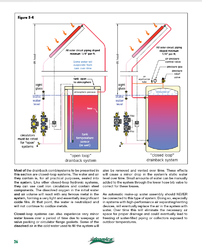First, read through Nofossil's site, there's a lot of good information there.
I use a grundfos 25-64 with 1" pex run up and back from about 260sf of old and abused flat plate panels, it provides space heating and heat storage until I add a bigger drainback tank with a 3/4" copper coil inside for DHW. This drainback system with plain water works fine through the winter, but with a boiler it might as well be shut off, there's just not that much solar energy available in winter.
I'll take a stab at the questions
1 the pump depends on the head and flow you want to achieve, which depends on whether you go with glycol, drainback (pump shuts off and water drains back into tank), or draindown (freeze detector goes off, valve opens, water drains out of system). Glycol is thicker, harder to pump, and a drainback system has a higher initial head to overcome.
2 I say go with pex for a water system, maybe not if you're useing glycol, if the water overheats it turns to steam and vents, if glycol overheats it turns acid, eats your copper and freezes, bursting your copper if the high temp didn't cause the pex to leak first. The pros wouldn't recommend pex. 1/2" is most likely too small to move the amount of water you need, as the collectors will work best with a low temp difference. 1/2" is what doitsolar.com uses in some collector designs.
3 the components you need depends again on what system you go with, a differential temp controller is nice, but my drainback pump runs on an old honeywell aquastat set at about 90degrees with the bulb in the top of one panel, no isolation valves, one drain valve.
4 if you use water no dump zone is needed. most likely the panels will only overheat if there's no circulation, so there's no reason to have a dump zone unless your two 120 gallon tanks get hot enough to to vent and that causes a problem, if that happens let us know how you built your panels please!
If you're building the panels from the ground up I'd use 1/2" pex for the collector piping, 1" pex for the supply and return, a small pump Taco 007 or so, and sleep well enough that even if you forget to drain it in September, the chance of any damage to frozen pex is pretty slight.
If you're using copper collectors, then I'd have to recommend using a drainback system that is very carefully designed not to allow water to remain in the collectors, or anywhere a freeze-leak would have bad consequences.
Let us know what your collector and other system plans are.


